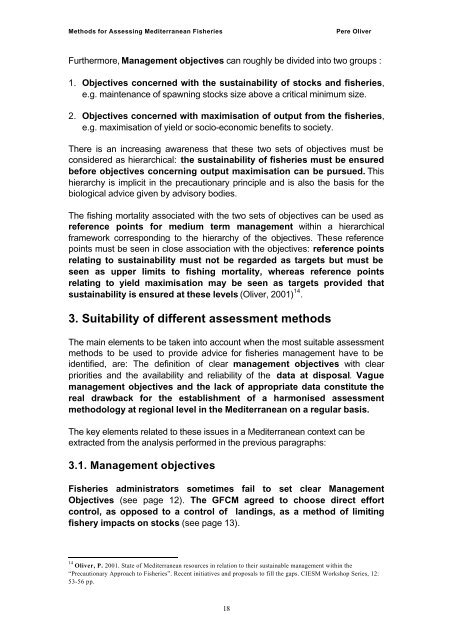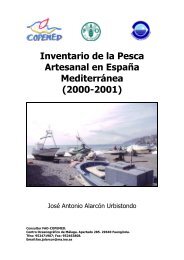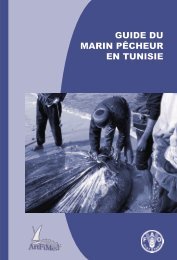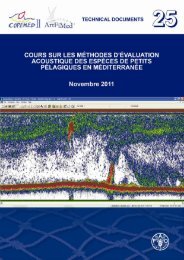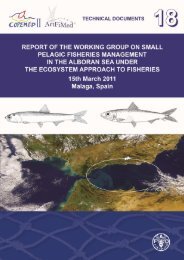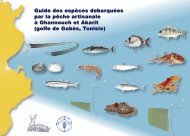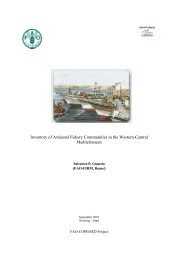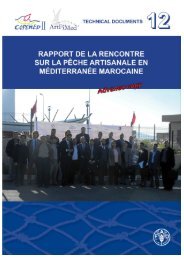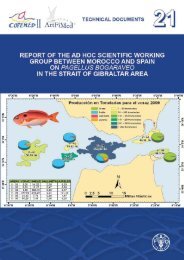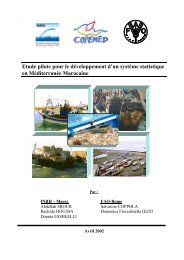Methods for Assessing Mediterranean Fisheries - Fao - Copemed
Methods for Assessing Mediterranean Fisheries - Fao - Copemed
Methods for Assessing Mediterranean Fisheries - Fao - Copemed
Create successful ePaper yourself
Turn your PDF publications into a flip-book with our unique Google optimized e-Paper software.
<strong>Methods</strong> <strong>for</strong> <strong>Assessing</strong> <strong>Mediterranean</strong> <strong>Fisheries</strong><br />
Pere Oliver<br />
Furthermore, Management objectives can roughly be divided into two groups :<br />
1. Objectives concerned with the sustainability of stocks and fisheries,<br />
e.g. maintenance of spawning stocks size above a critical minimum size.<br />
2. Objectives concerned with maximisation of output from the fisheries,<br />
e.g. maximisation of yield or socio-economic benefits to society.<br />
There is an increasing awareness that these two sets of objectives must be<br />
considered as hierarchical: the sustainability of fisheries must be ensured<br />
be<strong>for</strong>e objectives concerning output maximisation can be pursued. This<br />
hierarchy is implicit in the precautionary principle and is also the basis <strong>for</strong> the<br />
biological advice given by advisory bodies.<br />
The fishing mortality associated with the two sets of objectives can be used as<br />
reference points <strong>for</strong> medium term management within a hierarchical<br />
framework corresponding to the hierarchy of the objectives. These reference<br />
points must be seen in close association with the objectives: reference points<br />
relating to sustainability must not be regarded as targets but must be<br />
seen as upper limits to fishing mortality, whereas reference points<br />
relating to yield maximisation may be seen as targets provided that<br />
sustainability is ensured at these levels (Oliver, 2001) 14 .<br />
3. Suitability of different assessment methods<br />
The main elements to be taken into account when the most suitable assessment<br />
methods to be used to provide advice <strong>for</strong> fisheries management have to be<br />
identified, are: The definition of clear management objectives with clear<br />
priorities and the availability and reliability of the data at disposal. Vague<br />
management objectives and the lack of appropriate data constitute the<br />
real drawback <strong>for</strong> the establishment of a harmonised assessment<br />
methodology at regional level in the <strong>Mediterranean</strong> on a regular basis.<br />
The key elements related to these issues in a <strong>Mediterranean</strong> context can be<br />
extracted from the analysis per<strong>for</strong>med in the previous paragraphs:<br />
3.1. Management objectives<br />
<strong>Fisheries</strong> administrators sometimes fail to set clear Management<br />
Objectives (see page 12). The GFCM agreed to choose direct ef<strong>for</strong>t<br />
control, as opposed to a control of landings, as a method of limiting<br />
fishery impacts on stocks (see page 13).<br />
14 Oliver, P. 2001. State of <strong>Mediterranean</strong> resources in relation to their sustainable management within the<br />
“Precautionary Approach to <strong>Fisheries</strong>”. Recent initiatives and proposals to fill the gaps. CIESM Workshop Series, 12:<br />
53-56 pp.<br />
18


